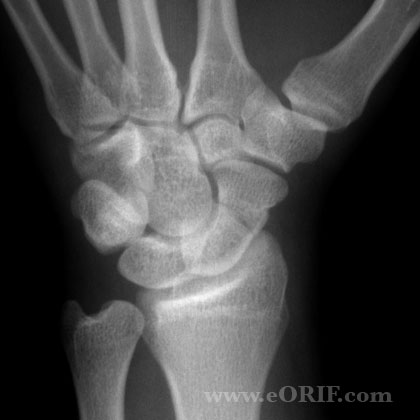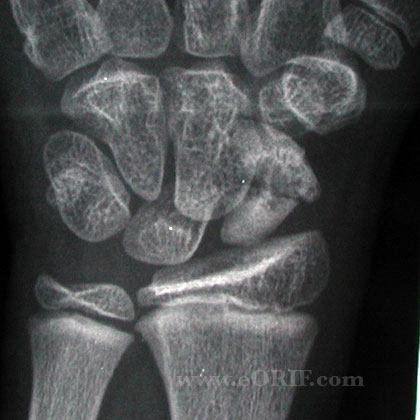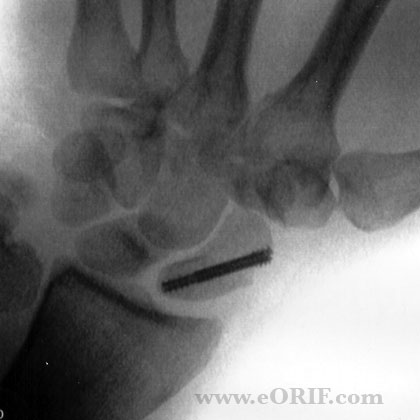|



|
synonyms: navicular fracture, carpal navicular fracture
Scaphoid Fracture ICD-10
A- initial encounter for closed fracture
B- initial encounter for open fracture
D- subsequent encounter for fracture with routine healing
G- subsequent encounter for fracture with delayed healing
K- subsequent encounter for fracture with nonunion
P- subsequent encounter for fracture with malunion
S- sequela
Scaphoid Fracture ICD-9
- 814.01(closed)
- 814.11(open)
Scaphoid Fracture Etiology / Epidemiology / Natural History
- Most common carpal fx. (70% of carpal fractures)
- Generally from fall on outstretched hand.
- Most common mechanisms of injury include: hyperextension and "punch" mechansim. During "punch" mechanism the force is transmitted to the distal pole of the scaphoid through the index metacarpal and trapezoid.
- typically young, working males; average age=25 years,
- Annual incidence = 4.3/10000 people (Hove LM, Scand J Plast Reconstr Surg Hand Surg 1999; 33: 423-426).
Scaphoid Fracture Anatomy
- Proximal pole is completely intraarticular and recieves blood supply from distal pole
- Superficial palmar branch of radial A volarly & dorsal capsal branch of radial A dorsally(80%)
- The majority of the blood supply to the scaphoid enters at the dorsal ridge.
- 65%waist fx, 25%proximal pole, 10%distal pole
- Enchondral ossification of the scaphoid begins at 5yrs 9 months in males and concludes at 15 yrs 3 months in males. It begins at 4yrs 5 months and concludes at 13 yrs 4 months in females (Stuart HC, Pediatrics 1962;29:237)
- Bipartite scaphoid occurs rarely and may represent asymptomatic nonunion (Doman AN, J Hand Surg 1990;15Am:869).
Scaphoid Fracture Clinical Evaluation
- Snuffbox tenderness
- Scaphoid tubercle tenderness
- Pain with axial loading of 1st metacarpal
Scaphoid Fracture Xray / Diagnositc Tests
- PA, Lateral, Scaphoid views of the wrist. Consider fisted PA view and posteroanterior grip view.
- CT scan: demonstrates the exact amount of displacement and loss of intrascaphoid and intercarpal alignment.
- MRI: helpful for occult acute fractures (especially proximal pole) and determining vascularity of scaphoid nonunions.
- Bone scan diagnostic at 48hrs (100% sensitive, 98%specific)
Scaphoid Fracture Classification / Treatment
- Stable (displacement <1mm, normal intercarpal alignment, Distal Pole fracture ): Short arm cast; consider percutaneous fixation. Contraindications to casting: displacement or angulation, small proximal pole fracture, concomitant scapholunate ligament injury, ipsilateral distal radius fracture, perilunate dislocation.
- Unstable (displaced >1mm, any proximal pole fracture, scapholunate angle >60º, any angulation, lateral intrascaphoid angle >35°, comminution): immediate percutaneous fixation due to @10% nonunion rate with cast treatment and significant morbidity of time off work, and activitiy limitations from cast treatment. Condiser ORIF if unable to achieve anatomic reduction percutaneously. (Rettig, J Hand Surg 26A:271;2001)
- Proximal pole fractures are unstable even when initially aligned = 30% nonunion rate with cast treatment. (Gutow AP, JAAOS 2007;15:474).
Scaphoid Fracture Associated Injuries / Differential Diagnosis
- Scapholunate instability
- Bennett's Fx
- Distal radius Fx
- Scaphoid Fx
- Preiser's Disease
Scaphoid Fracture Complications
- Nonunion=failure to heal in 6 months. 5-10% for undisplaced, up to 90% for displaced proximal pole. (Hambridge JE, JBJS 1999;81Br:934).
- AVN: 30% of prox 1/3rdfx, 100% of prox 1/5 fx
- CRPS
- Hematoma
- Infection
- Nerve or vascular injury
- Stiffness
- Casting Complications: disuse muscle atrophy and osteopenia, delayed union, nonunion, pressure nerve palsies, cast sores / pressure sores.
Scaphoid Fracture Follow up care
- Post-Op: Place in volar splint. Encourage digital ROM, elevation.
- 7-10 Days: remove splint. Place in short arm spica thumb spica cast. Consider removable splint with gentle ROM if fixation was extremely secure.
- 6 Weeks: Cast removed. Check xrays. Started gentle ROM exercises. Activity modifications: no heavy manual labor, no contact sports, no lifting >5 lbs.
- 3 Months: Check xrays. If union is complete return to full activities.
Scaphoid Fracture Review References
- Greens Hand Surgery
- Cooney WP III: Scaphoid fractures: Current treatments and techniques. Instr Course Lect 2003;52:197-208.
- Cooney WP, Linscheid RL, Dobyns JH, Wood MB: Scaphoid nonunion: Role of anterior interpositional bone grafts. J Hand Surg Am 1988;13:635-650.
- Fernandez DL: A technique for anterior wedge-shaped grafts for scaphoid nonunions with carpal instability. J Hand Surg Am 1984;9:733-737.
- Stark HH, Rickard TA, Zemel NP, Ashworth CR: Treatment of ununited fractures of the scaphoid by illiac bone grafts and Kirschner-wire fixation. J Bone Joint Surg Am 1988;70:982-991.
- Feldman MD, Manske PR, Welch RL, Szerzinski JM: Evaluation of Herbert screw fixation for the treatment of displaced scaphoid nonunions. Orthopedics 1997;20:325-328.
|



